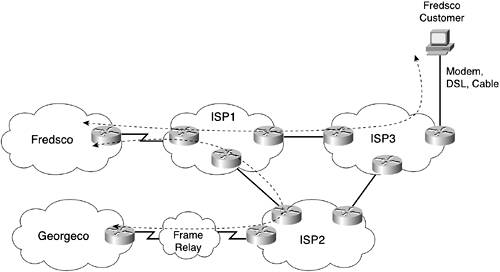Once on the Interstate (Internet), You Can Go Anywhere
| Chapters 14 and 15 compared WANs to the interstate several times. The U.S. Department of Transportation (DOT) builds the interstates, and companies can transport goods using the roads; you can go visit grandma or do anything you wantas long as you obey the rules of the road. But the individual businesses that use the roads obviously don't build the roads. The same general idea applies to WANs and the telephone company (telco). A company can't run a cable between two far-away buildings for legal and practical reasons. But the telco already has the ability to let you connect to its network physically, and then deliver the data over its network to the other office building. However, with WAN links, the telco allows two sites to communicate. With Frame Relay, many sites can communicate, but they all must use the same Frame Relay service from the same telco. Now, take that same concept of having a provider of WAN servicethe people I've been calling the telcoand apply it to the Internet. A company can connect to the Internet, typically with a WAN link or with Frame Relay. With that one physical connection, that company gains access to a huge number of people (literally billions of people) who also have access to the Internet. Figure 16-1 shows the basic idea. Figure 16-1. Reaching the World Through One Connection to the Internet In the figure, ISP represents the term Internet service provider. An ISP creates a network over which IP packets can be forwarded, similar to the way a telco creates a network over which bits (for WAN links) and Frame Relay frames (for Frame Relay) can be forwarded. In fact, some ISPs are also telcos. The Internet consists of three major components:
As you see in Figure 16-1, Fredsco's headquarters is now connected to the Internet. To connect to ISP1, Fredsco uses a point-to-point WAN link. In Chapter 14, the WAN links connect routers inside the Fredsco internal network. Now, a WAN link connects a FredsCo router to a router at ISP1. IP routing is the key to appreciating what the Internet provides to Fredsco. Because Fredsco's router connects to a router in ISP1, it can forward packets to and from that router. And because the rest of the Internet is connected out there, somehow, someway, IP hosts in Fredsco's network can send and receive data to and from the rest of the IP hosts in the Internet. For instance, in Figure 16-1, Fredsco could exchange data with his supplier, GeorgeCo, who's connected to ISP2 over a Frame Relay permanent virtual circuit (PVC). Also, customers can connect to their local ISPs using the technologies you'll learn about in the rest of this chapter. Then, customers can order things from Fredsco from Fredsco's website, send e-mails to Fredsco's customer service department, and so on. Notice that the actual connectivity between Fredsco and ISP1 and between GeorgeCo and ISP2 are familiar services from the telco (WAN link and Frame Relay, respectively). Because I've already covered those, the rest of this chapter focuses on some other WAN technologies, mainly ones that are used to access the Internet from home. Table 16-1 summarizes the three options for WAN connectivity that you've learned about in this part of the book, with a few comments.
The rest of this chapter covers three popular technologies that are most often used today to connect to an ISP. Most of the time, people use these technologies at their homes. One of the main distinctions is that these three technologies take advantage of cabling that is typically already installed into a home, namely the phone line, or the cable TV cable. By using cabling that is already installed in the home, an ISP spends less money, making the service cheaper to the customer. Also, the time required getting the customer up and working can be reduced. |
EAN: 2147483647
Pages: 173